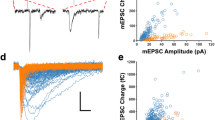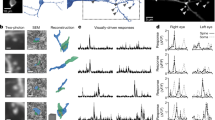Abstract
THE rearrangement of synaptic connections during normal and deprived development is thought to be controlled by correlations in afferent impulse activity1. A favoured model is based on postsynaptic detection of synchronously active afferents; synapses are stabilized when pre- and postsynaptic activity is correlated and weakened or eliminated when their activity is uncorrelated2,3. Most evidence for this model comes from demonstrations that correlated afferent input is necessary for the segregation of eye-dominant inputs in the developing vertebrate visual system1,4,5 and that critical period plasticity of ocular dominance columns in cat visual cortex is disrupted by blockade of postsynaptic transmission6–8. We tested whether the developmental plasticity of somatosensory columns, known as 'barrels', in rodent primary somatosensory cortex (S1)9–13 is similar to that of ocular dominance columns. We report here that the selective disruption of postsynaptic activation in rat S1 by application of a glutamate receptor antagonist inhibits rearrangements in the somatotopic patterning of thalamocorticalafferents induced by manipulations of the sensory periphery during the critical period. These findings show that postsynaptic activation has a prominent role in critical period plasticity in S1 cortex.
This is a preview of subscription content, access via your institution
Access options
Subscribe to this journal
Receive 51 print issues and online access
$199.00 per year
only $3.90 per issue
Buy this article
- Purchase on Springer Link
- Instant access to full article PDF
Prices may be subject to local taxes which are calculated during checkout
Similar content being viewed by others
References
Shatz, C. J. Neuron 5, 745–756 (1990).
Hebb, D. O. The Organization of Behaviour (Wiley, New York) (1949).
Stent, G. S. Proc. natn. Acad. Sci. U.S.A. 70, 997–1001 (1973).
Constantine-Paton, M., Cline, H. T. & Debski, E. A. Rev. Neurosci. 13, 129–154 (1991).
Stryker, M. P. & Harris, W. J. Neurosci 6, 2117–2133 (1986).
Bear, M. F., Kleinschmitt, A., Gu, Q. & Singer, W. J. Neurosci. 10, 909–925 (1990).
Reiter, H. O., Waitzman, D. M. & Stryker, M. P. Expl Brain Res. 65, 182–188 (1986).
Reiter, H. O. & Stryker, M. P. Proc. natn. Acad. Sci. U.S.A. 85, 3623–3627 (1989).
Woolsey, T. A. & Van der Loos, H. Brain Res. 1, 205–242 (1970).
Van der Loos, H. & Woolsey, T. A. Science 179, 395–398 (1973).
Killackey, H. P. & Leshin, S. Brain Res. 86, 469–472 (1975).
Woolsey, T. A. & Wann, J. R. J. comp. Neurol. 170, 53–66 (1976).
Belford, G. R. & Killackey, H. P. J. comp. Neurol. 193, 335–350 (1980).
Erzurumlu, R. S. & Jhaveri, S. Devl Brain Res. 56, 229–234 (1990).
Schlaggar, B. L. & O'Leary, D. D. M. Perspect. dev. Neurobiol. 1, 81–91 (1993).
Agmon, A. & O'Dowd, D. K. J. Neurophysiol. 68, 345–348 (1992).
Robertson, R. T. Neurosci. Lett. 75, 259–264 (1987).
Kleinschmidt, A., Bear, M. F. & Singer, W. Science 238, 355–358 (1987).
Wiesel, T. N. & Hubel, D. H. J. Neurophysiol. 28, 1029–1040 (1965).
LeVay, S., Wiesel, T. N. & Hubel, D. H. J. comp. Neurol. 191, 1–51 (1980).
Henderson, T. A., Woolsey, T. A. & Jacquin, M. F. Devl Brain Res. 66, 146–152 (1992).
Chiaia, N. L., Fish, S. E., Bauer, W. R., Bennett-Clarke, C. A. & Rhoades, R. W. Devl Brain Res. 66, 244–250 (1992).
Fox, K. J. Neurosci. 12, 1826–1838 (1992).
McCasland, J. S., Bernardo, K. L., Probst, K. L. & Woolsey, T. A. Proc. natn. Acad. Sci. U.S.A. 89, 1832–1836 (1992).
Simon, D. K., Prusky, G. T., O'Leary, D. D. M. & Constantine-Paton, M. Proc. natn. Acad. Sci. U.S.A. 89, 10593–10597 (1992).
Hahm, J.-O., Langdon, R. B. & Sur, M. Nature 351, 568–570 (1991).
Cline, H. T. & Constantine-Paton, M. Neuron 3, 413–426 (1989).
Cline, H. T., Debski, E. A. & Constantine-Paton, M. Proc. natn. Acad. Sci. U.S.A. 84, 4342–4345 (1987).
Bear, M. F., Carnes, K. M. & Ebner, F. F. J. comp. Neurol. 234, 411–430 (1985).
Honore, T. et al. Science 214, 1701–1703 (1988).
Author information
Authors and Affiliations
Rights and permissions
About this article
Cite this article
Schlaggar, B., Fox, K. & O'Leary, D. Postsynaptic control of plasticity in developing somatosensory cortex. Nature 364, 623–626 (1993). https://doi.org/10.1038/364623a0
Received:
Accepted:
Issue Date:
DOI: https://doi.org/10.1038/364623a0
This article is cited by
-
Chemical Neurotransmission from Retinal Ganglion Cells to Superior Colliculus Neurons under Conditions of Long-Lasting Neighboring Co-Culturing
Neurophysiology (2012)
-
Postsynaptic excitability is necessary for strengthening of cortical sensory responses during experience-dependent development
Nature Neuroscience (2006)
-
Receptors of glutamate and neurotrophin in vestibular neuronal functions
Journal of Biomedical Science (2003)
-
Périodes critiques de plasticité des cartes sensorielles corticales
PSN (2003)
Comments
By submitting a comment you agree to abide by our Terms and Community Guidelines. If you find something abusive or that does not comply with our terms or guidelines please flag it as inappropriate.



